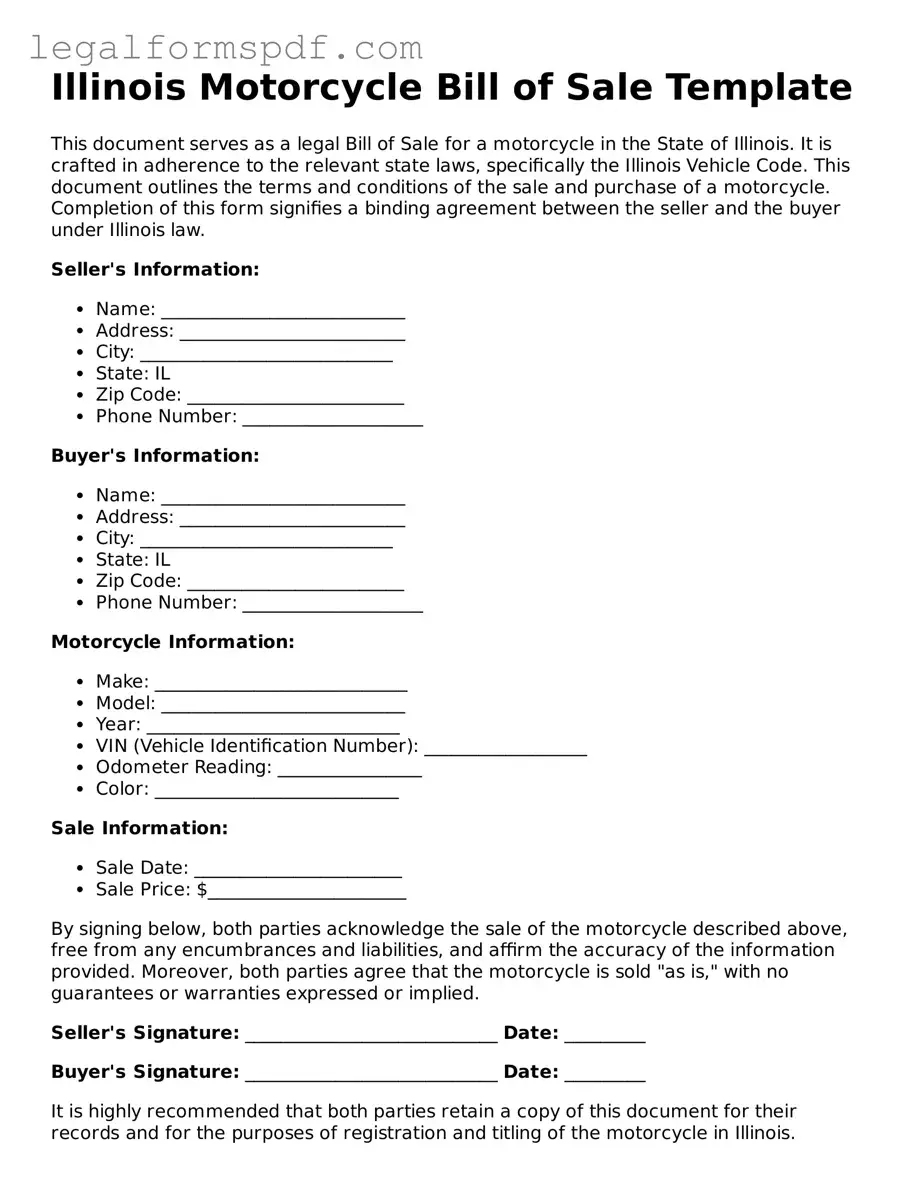The Illinois Motorcycle Bill of Sale form shares similarities with the Vehicle Bill of Sale form used in many states for the sale of cars, trucks, and boats. Both documents serve as a legal record that a transaction between a buyer and a seller has occurred, detailing the sale of a specific asset. They typically include important information such as the make, model, year, and identification number of the vehicle, as well as the price, date of sale, and parties' information. The primary role of both forms is to protect the rights of both buyer and seller, providing a receipt for the transaction.
Another related document is the General Bill of Sale. This form is broader and can be used for the sale of various types of personal property — from electronics to furniture. While it serves a similar purpose of documenting the sale and transfer of ownership, it is less specific about the item being sold and might not include specific identifiers like a vehicle identification number. However, like the Motorcycle Bill of Sale, it records the essential details of the transaction, including the parties involved, description of the item, sale amount, and date of sale.
The Warranty Deed is akin to the Motorcycle Bill of Sale in that it is used in real estate transactions to transfer property ownership from a seller to a buyer. While it pertains to real estate rather than vehicles, both documents serve to legally document the change in ownership and protect the interests of both parties. A Warranty Deed also guarantees that the property is free from any undisclosed encumbrances, much like a Motorcycle Bill of Sale ensures the motorcycle is sold as described.
Similarly, a Quitclaim Deed, while used in real estate to transfer any ownership interest a person might have in a property, aligns with the Motorcycle Bill of Sale's objective to transfer ownership. Unlike a Warranty Deed, a Quitclaim Deed does not guarantee that the title is clear. It simply transfers whatever interest the seller has, similar to how a Bill of Sale transfers ownership of a motorcycle without warranties unless stated otherwise.
A Promissory Note is comparable to a Motorcycle Bill of Sale when financing is involved. This legal document details a borrower's promise to repay a lender according to agreed terms. While it does not transfer ownership of an item like a Bill of Sale, it is often used in conjunction with one to outline the terms of payment for the item being sold, specifying the loan amount, interest rate, and repayment schedule.
The Livestock Bill of Sale is specific to the sale of animals such as cattle, horses, and other farm animals but is conceptually similar to the Motorcycle Bill of Sale. Both documents serve as proof of purchase and transfer of ownership, listing details key to the transaction such as the animal's or vehicle's description, the sale price, and identifying information. These details are crucial for legal protection and recording purposes.
Lastly, the Firearms Bill of Sale parallels the Motorcycle Bill of Sale in that it documents the sale and transfer of a specific type of personal property, in this case, firearms. Both are critical for legally recording the transaction, including the transfer of ownership, item specifics, and the buyer and seller's details. Especially for firearms, the document aids in tracing ownership and ensuring the sale complies with federal and state laws, much as the Motorcycle Bill of Sale helps in establishing legal ownership and possibly assisting in vehicle registration processes.
